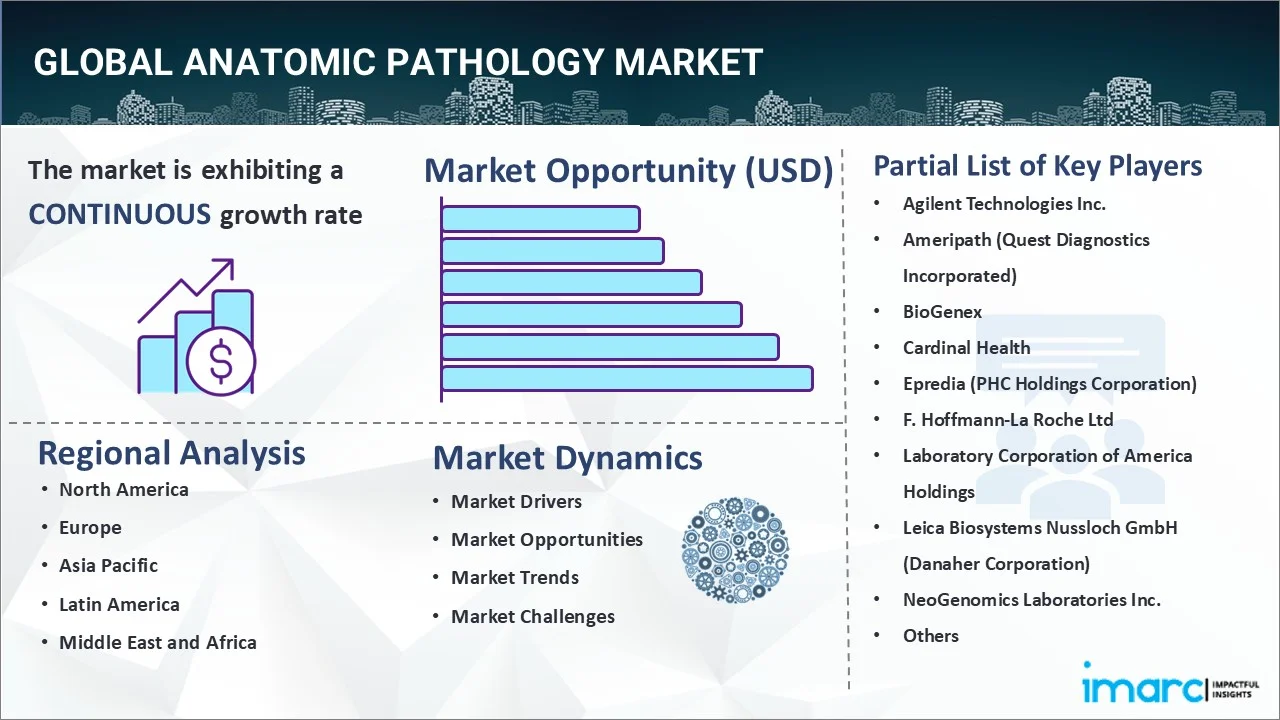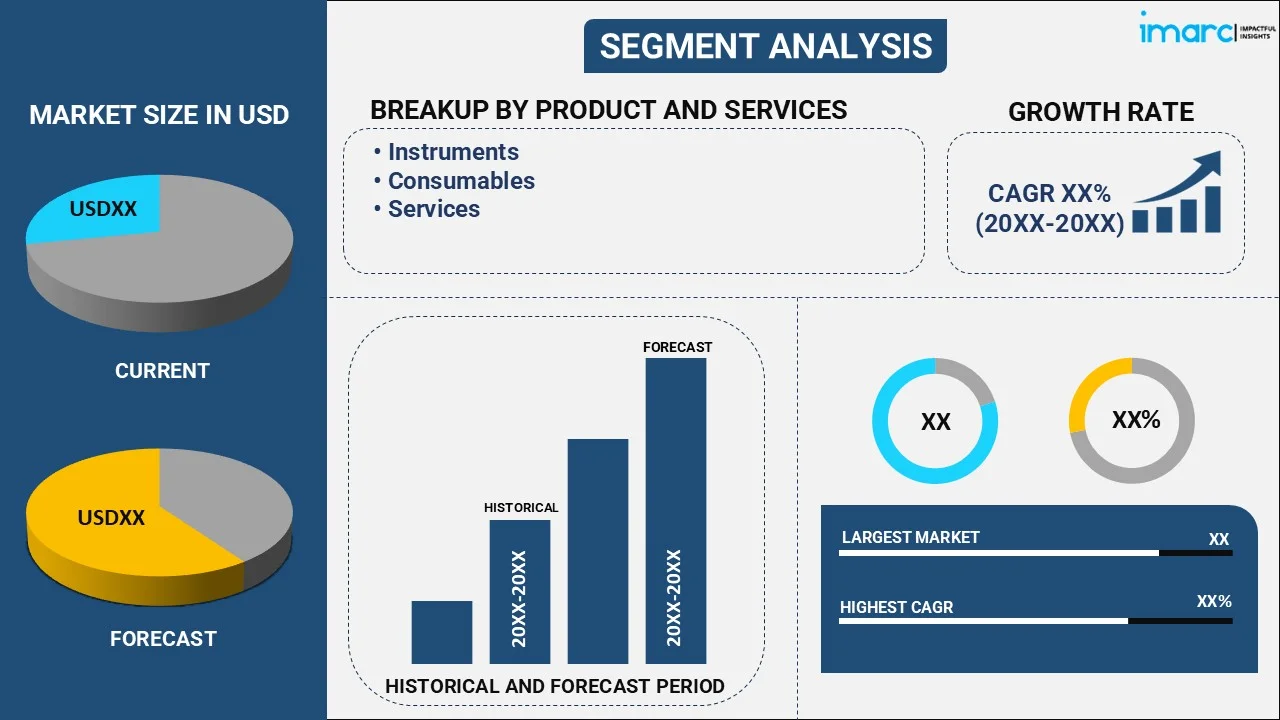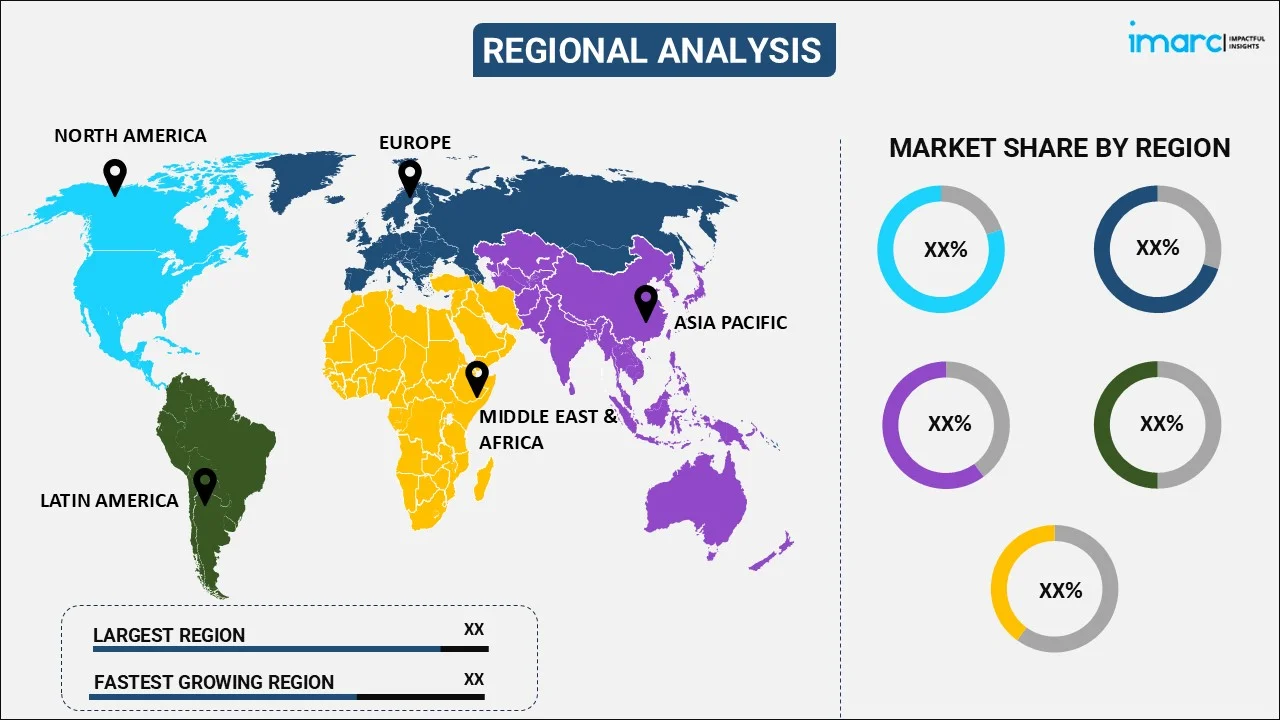
Anatomic Pathology Market Report by Product and Services (Instruments, Consumables, Services), Application (Disease Diagnosis, Drug Discovery and Development, and Others), End User (Hospitals, Research Laboratories, Diagnostic Laboratories, and Others), and Region 2025-2033
Anatomic Pathology Market Size and Share:
The global anatomic pathology market size reached USD 41.3 Billion in 2024. Looking forward, IMARC Group expects the market to reach USD 77.6 Billion by 2033, exhibiting a growth rate (CAGR) of 6.92% during 2025-2033. The market is experiencing steady growth driven by the increasing prevalence of cancer, continuous technological advancements in the healthcare industry, and the integration of molecular techniques, particularly in companion diagnostics, which is shaping the future of personalized medicine.
|
Report Attribute
|
Key Statistics
|
|---|---|
|
Base Year
|
2024 |
|
Forecast Years
|
2025-2033
|
|
Historical Years
|
2019-2024
|
| Market Size in 2024 | USD 41.3 Billion |
| Market Forecast in 2033 | USD 77.6 Billion |
| Market Growth Rate (2025-2033) | 6.92% |
Anatomic Pathology Market Analysis:
- Market Growth and Size: The global anatomic pathology market is witnessing stable growth, driven by the escalating demand for diagnostic services.
- Technological Advancements: The integration of digital pathology and AI technologies is streamlining diagnostic processes, enhancing efficiency, and consequently contributing to market growth.
- Industry Applications: In addition, the rising awareness about the importance of personalized medicine, which requires precise pathological assessments, is supporting the market growth.
- Geographical Trends: North America dominates the anatomic pathology market due to well-established healthcare infrastructure. However, the Asia-Pacific region is experiencing rapid growth, primarily driven by increasing healthcare investments and a rising patient pool.
- Competitive Landscape: The market is highly competitive and mergers and acquisitions (M&A) are common strategies used in the industry to expand service portfolios.
- Challenges and Opportunities: The rising shortage of skilled pathologists and the increasing need for standardization in pathology practices are posing challenges to the anatomic pathology market. Nonetheless, increasing use of AI by leading players for more accurate diagnoses and expanding into emerging markets where healthcare infrastructure is evolving.
- Future Outlook: The future of the anatomic pathology market looks promising, driven by ongoing technological advancements. Additionally, increasing collaborations with pharmaceutical companies and continuous growth of personalized medicines is offering a favorable market outlook.

Anatomic Pathology Market Trends:
Increasing cancer incidence and demand for personalized medicine:
The rise in cancer incidence, driven by factors like aging populations and lifestyle changes represents one of the primary factors catalyzing the demand for advanced diagnostic tools and personalized treatment approaches. Anatomic pathologists analyze tissue samples obtained from biopsies or surgical resections to identify cancerous cells, determine tumor type and grade, and assess the extent of disease spread. Furthermore, the integration of molecular and genetic testing is enabling the identification of specific genetic mutations and biomarkers that guide targeted therapies. This convergence of traditional pathology with molecular techniques is leading to the emergence of molecular pathology, expanding the applications of anatomic pathology. Molecular pathology techniques enable pathologists to identify specific genetic mutations and alterations within cancer cells. Moreover, the information obtained through molecular pathology allows for personalized treatment approaches. It helps oncologists tailor therapies based on the tumor profile of an individual. In addition, molecular pathology helps researchers understand the molecular underpinnings of cancer, identify potential therapeutic targets, and develop new drugs or therapies.
Technological advancements and automation:
Advancements in technology and laboratory automation are improving anatomic pathology, making diagnostic processes more efficient, accurate, and accessible. Additionally, the increasing adoption of automation in histopathology is reducing the time required for tissue processing, staining, and slide preparation, resulting in faster turnaround times for patient diagnoses. Along with this, the development of digital pathology is enabling pathologists to view and analyze tissue samples remotely. This transition to digital format streamlines the workflow of pathologists, enabling them to collaborate remotely, consult experts worldwide, and maintain comprehensive patient records. It also reduces the risk of slide damage during transport. Furthermore, it enhances collaboration among pathologists and facilitates the integration of artificial intelligence (AI) and machine learning algorithms for image analysis. AI-powered tools can assist in identifying patterns, anomalies, and potential biomarkers in tissue samples, improving diagnostic accuracy and efficiency. This capability enhances diagnostic accuracy, especially in complex cases. AI-driven diagnostics can expedite critical diagnoses, particularly in cases of time-sensitive diseases like cancer.
Rising demand for companion diagnostics and precision medicine:
The escalating demand for companion diagnostics is strengthening the growth of the market. Anatomic pathology supports companion diagnostics by providing the necessary insights into tumor characteristics and genetic markers. Companion diagnostics enable healthcare providers to tailor treatment plans to individual patients and reduce the risk of unnecessary side effects and healthcare costs associated with ineffective treatments. Anatomic pathologists use various laboratory techniques, including immunohistochemistry and molecular testing, to identify these markers within tissue samples. In line with this, the increasing emphasis on personalized medicine and the development of new therapeutic agents that rely on companion diagnostics are driving the demand for anatomic pathology services. Laboratories specializing in anatomic pathology work closely with pharmaceutical companies, diagnostic test developers, and healthcare providers to validate and implement companion diagnostic tests. They provide the necessary expertise to ensure that these tests are accurate, reproducible, and meet regulatory standards. This collaboration facilitates the successful integration of companion diagnostics into clinical practice.
Anatomic Pathology Industry Segmentation:
IMARC Group provides an analysis of the key trends in each segment of the market, along with forecasts at the global, regional, and country levels for 2025-2033. Our report has categorized the market based on product and services, application, and end user.
Breakup by Product and Services:

- Instruments
- Microtomes and Cryostat
- Tissue Processors
- Automatic Stainer
- Whole Slide Imaging (WSI) Scanners
- Others
- Consumables
- Reagents and Antibodies
- Probes and Kits
- Others
- Services
Consumables account for the majority of the market share
The report has provided a detailed breakup and analysis of the market based on the product and services. This includes instruments [microtomes and cryostat, tissue processors, automatic stainer, whole slide imaging (WSI) scanners, and others], consumables [reagents and antibodies, probes and kits, and others], and services. According to the report, consumables represented the largest segment.
Consumables consist of reagents and antibodies, probes and kits, and other essential supplies. They aid in the staining, analysis, and molecular testing of tissue samples. In addition, they support the expansion of personalized medicine through companion diagnostics and molecular pathology.
Instruments play a critical role in tissue preparation, staining, and imaging, facilitating the accurate diagnosis of diseases. In addition, the escalating demand for these instruments is driving the need for precision and efficiency in pathology laboratories.
Breakup by Application:
- Disease Diagnosis
- Drug Discovery and Development
- Others
Disease diagnosis holds the largest share in the industry
A detailed breakup and analysis of the market based on the application have also been provided in the report. This includes disease diagnosis, drug discovery and development, and others. According to the report, disease diagnosis accounted for the largest market share.
Disease diagnosis involves the analysis of tissue samples obtained from biopsies or surgical resections to identify various diseases, including cancer, infectious diseases and autoimmune disorders. In addition, the increasing prevalence of diseases, particularly cancer, is driving the demand for precise diagnostic services, making disease diagnosis the dominant application in anatomic pathology.
The drug discovery and development segment focuses on supporting pharmaceutical companies and researchers in the development of new therapies and drugs. Anatomic pathology helps in preclinical and clinical studies, helping assess the safety and efficacy of potential drug candidates. It aids in evaluating drug-induced tissue changes and provides insights into the mechanism of action.
Breakup by End User:
- Hospitals
- Research Laboratories
- Diagnostic Laboratories
- Others
Hospitals hold the largest market share
The report has provided a detailed breakup and analysis of the market based on the end user. This includes hospitals, research laboratories, diagnostic laboratories, and others. According to the report, hospitals represented the largest segment.
Hospitals rely heavily on anatomic pathology for disease diagnosis, treatment planning, and patient care. Pathologists in hospital settings handle a wide range of cases, from routine diagnostics to complex diseases, making hospitals the primary customer base for anatomic pathology services. The increasing burden of diseases and the need for accurate and timely diagnoses within hospital settings continue to drive the demand for these services.
Research laboratories constitute another significant segment in the anatomic pathology market. These laboratories are often associated with academic institutions and research centers. They use anatomic pathology services to support scientific investigations, preclinical studies, and experimental research. Anatomic pathology aids in advancing our understanding of diseases and developing new treatments.
Diagnostic laboratories, including independent clinical laboratories and reference laboratories, provide diagnostic testing services to healthcare providers, including physicians and hospitals. Anatomic pathology services are an integral part of their diagnostic offerings, contributing to the accurate identification and classification of diseases.
Breakup by Region:

- North America
- United States
- Canada
- Europe
- Germany
- France
- United Kingdom
- Italy
- Spain
- Others
- Asia Pacific
- China
- Japan
- India
- South Korea
- Australia
- Indonesia
- Others
- Latin America
- Brazil
- Mexico
- Others
- Middle East and Africa
North America leads the market, accounting for the largest anatomic pathology market share
The market research report has also provided a comprehensive analysis of all the major regional markets, which include North America (the United States and Canada); Europe (Germany, France, the United Kingdom, Italy, Spain, and others); Asia Pacific (China, Japan, India, South Korea, Australia, Indonesia, and others); Latin America (Brazil, Mexico, and others); and the Middle East and Africa. According to the report, North America accounted for the largest market share.
The North America anatomic pathology market is largely driven by the well-established healthcare infrastructure, high prevalence of chronic diseases, and significant investments in advanced diagnostic technologies. The United States, in particular, leads the market with a robust healthcare system and a growing demand for precision medicine.
Europe holds a larger segment of the anatomic pathology market due to the presence of advanced healthcare systems and a strong emphasis on research and development (R&D). Additionally, countries like Germany and France are at the forefront of adopting digital pathology and molecular techniques, driving the growth of this market segment.
The Asia Pacific region is experiencing rapid growth in the anatomic pathology market due to the rising population, increasing healthcare investments, and a growing burden of diseases, especially in countries like China and India, contributing to this growth. The increasing adoption of advanced diagnostic technologies and the expansion of healthcare infrastructure are key drivers in this region.
Latin America represents a developing market for anatomic pathology. The region is witnessing increasing healthcare investments and a rising demand for diagnostic services. Brazil and Mexico, in particular, are emerging as key players in this market, driven by their expanding healthcare systems and growing patient populations.
The Middle East and Africa are also showing steady growth in the anatomic pathology market. Countries in the Gulf region, such as Saudi Arabia and the United Arab Emirates, are making significant investments in healthcare infrastructure, contributing to the expansion of anatomic pathology services. In Africa, there is a growing focus on improving diagnostic capabilities to address healthcare challenges.
Leading Key Players in the Anatomic Pathology Industry:
Anatomic pathology companies are investing in cutting-edge diagnostic technologies such as digital pathology, whole-slide imaging, and artificial intelligence (AI) for image analysis. These technologies enhance the efficiency and accuracy of pathology services. Additionally, many companies are integrating molecular pathology into their offerings, combining traditional histopathology with molecular testing to provide a more comprehensive diagnostic approach. This enables the identification of genetic mutations and biomarkers critical for personalized medicine. Along with this, they are actively collaborating with pharmaceutical companies to develop and validate companion diagnostic tests for targeted therapies. This involves identifying specific genetic markers or biomarkers that can guide treatment decisions. Moreover, they are continuously investing in research and development (R&D) activities to develop novel diagnostic assays, improve existing testing methods, and explore new applications for anatomic pathology in areas like oncology, infectious diseases, and genetic disorders.
The market research report has provided a comprehensive analysis of the competitive landscape. Detailed profiles of all major companies have also been provided. Some of the key players in the market include:
- Agilent Technologies Inc.
- Ameripath (Quest Diagnostics Incorporated)
- BioGenex
- Cardinal Health
- Epredia (PHC Holdings Corporation)
- F. Hoffmann-La Roche Ltd
- Laboratory Corporation of America Holdings
- Leica Biosystems Nussloch GmbH (Danaher Corporation)
- NeoGenomics Laboratories Inc.
- Sakura Finetek USA, Inc. (Olympus Corporation)
(Please note that this is only a partial list of the key players, and the complete list is provided in the report.)
Anatomic Pathology Market Report Scope:
| Report Features | Details |
|---|---|
| Base Year of the Analysis | 2024 |
| Historical Period | 2019-2024 |
| Forecast Period | 2025-2033 |
| Units | Billion USD |
| Scope of the Report | Exploration of Historical and Forecast Trends, Industry Catalysts and Challenges, Segment-Wise Historical and Predictive Market Assessment:
|
| Product and Services Covered |
|
| Applications Covered | Disease Diagnosis, Drug Discovery and Development, Others |
| End Users Covered | Hospitals, Research Laboratories, Diagnostic Laboratories, Others |
| Regions Covered | North America, Europe, Asia Pacific, Latin America, Middle East and Africa |
| Countries Covered | United States, Canada, Germany, France, United Kingdom, Italy, Spain, China, Japan, India, South Korea, Australia, Indonesia, Brazil, Mexico |
| Companies Covered | Agilent Technologies Inc., Ameripath (Quest Diagnostics Incorporated), BioGenex, Cardinal Health, Epredia (PHC Holdings Corporation), F. Hoffmann-La Roche Ltd, Laboratory Corporation of America Holdings, Leica Biosystems Nussloch GmbH (Danaher Corporation), NeoGenomics Laboratories Inc., Sakura Finetek USA, Inc. (Olympus Corporation), etc. |
| Customization Scope | 10% Free Customization |
| Post-Sale Analyst Support | 10-12 Weeks |
| Delivery Format | PDF and Excel through Email (We can also provide the editable version of the report in PPT/Word format on special request) |
Key Questions Answered in This Report:
- How has the global anatomic pathology market performed so far, and how will it perform in the coming years?
- What are the drivers, restraints, and opportunities in the global anatomic pathology market?
- What is the impact of each driver, restraint, and opportunity on the global anatomic pathology market?
- What are the key regional markets?
- Which countries represent the most attractive anatomic pathology market?
- What is the breakup of the market based on the product and services?
- Which is the most attractive product and services in the anatomic pathology market?
- What is the breakup of the market based on the application?
- Which is the most attractive application in the anatomic pathology market?
- What is the breakup of the market based on the end user?
- Which is the most attractive end user in the anatomic pathology market?
- What is the competitive structure of the anatomic pathology market?
- Who are the key players/companies in the global anatomic pathology market?
Key Benefits for Stakeholders:
- IMARC’s industry report offers a comprehensive quantitative analysis of various market segments, historical and current market trends, market forecasts, and dynamics of the anatomic pathology market from 2019-2033.
- The research report provides the latest information on the market drivers, challenges, and opportunities in the global anatomic pathology market.
- The study maps the leading, as well as the fastest-growing, regional markets. It further enables stakeholders to identify the key country-level markets within each region.
- Porter's five forces analysis assists stakeholders in assessing the impact of new entrants, competitive rivalry, supplier power, buyer power, and the threat of substitution. It helps stakeholders to analyze the level of competition within the anatomic pathology industry and its attractiveness.
- The competitive landscape allows stakeholders to understand their competitive environment and provides insight into the current positions of key players in the market.
Need more help?
- Speak to our experienced analysts for insights on the current market scenarios.
- Include additional segments and countries to customize the report as per your requirement.
- Gain an unparalleled competitive advantage in your domain by understanding how to utilize the report and positively impacting your operations and revenue.
- For further assistance, please connect with our analysts.
 Request Customization
Request Customization
 Speak to an Analyst
Speak to an Analyst
 Request Brochure
Request Brochure
 Inquire Before Buying
Inquire Before Buying




.webp)




.webp)












